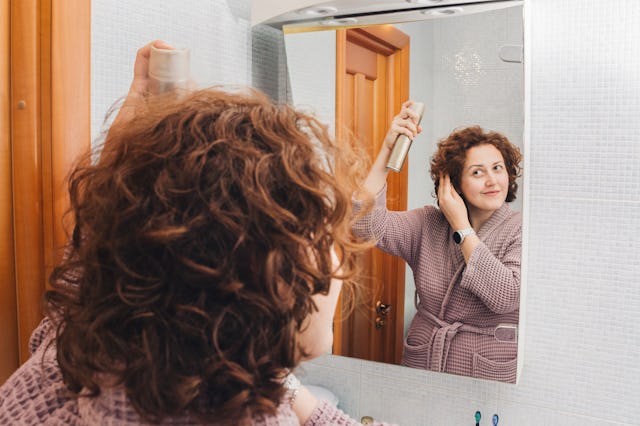Are You Using Heat Protectant Wrong?
An expert shares their best tips on making sure your heat protectant spray does what it’s supposed to.

As I age, there are a few things I refuse to go without in the beauty department. I can not leave the house without moisturizer and mascara, and I can not do anything to my hair until I coat it with heat protectant spray. It is my version of the ‘80s moms’ love of hairspray — I’m convinced it not only protects my hair, but keeps it softer, shinier, and gives it more volume. I have no idea if I’m right and honestly, I have no idea if there’s a proper way to use heat protectant. I just kind of coat my hair in a cloud and hope it all works out.
Luckily, it’s not rocket science, but you may be doing some things wrong when you use your own heat protectant spray.
How To Use Heat Protectant Spray The Right Way
The formula
For starters, you really need to make sure you’re buying a formula that works best for your hair type and texture. Celebrity hair stylist and John Frieda Hair Care Ambassador, DJ Quintero tells Scary Mommy that you should be aware of the weight of the product, “meaning some are lighter, meaning good for fine hair, and some are heavier, good for thicker or coarser hair. Does the heat protectant add shine? Does it add a lot of build-up or get greasy? Does it help moisturize and fight frizz? How quickly does it absorb into the hair? Those are the factors you want to consider.”
Your timing
I asked Quintero if there was any kind of time limit when it came to heat protectant — like should you be spraying it and then waiting a bit before adding heat — but he says this depends on whether you spray it onto damp or dry hair. “I usually prefer to spray on damp hair and blow it into the hair, then I don’t have to worry about wait time.”
Your technique
As far as actually spraying the heat protectant spray, if you’re just sort of slightly misting it all over your head, you’re doing it wrong. Quintero recommends spraying your entire head, from roots to the shaft. If you’re only worried about your ends or have noticed they seem more damaged than the rest of your hair, then load the spray up on them. Quintero says spray methods may also depend on the product and how fast it absorbs into the hair, but you really want to make sure it’s getting everywhere.
But the biggest shock for me with heat protectant spray? Brushing it through your hair. I can honestly say this is something I’ve never done — I think I’m carrying old hair spray logic with me and it feels like I’m messing something up — but I always brush my hair first, then spray, then add heat. Quintero says we should always “brush the hair afterwards on damp hair for an even distribution” and to make sure you concentrate on spraying lots of protectant on your ends as they are the “oldest and usually most damaged part of the hair.”
I know I’ll be implementing these tips ASAP. Wishing you smooth ends and no flyaways.